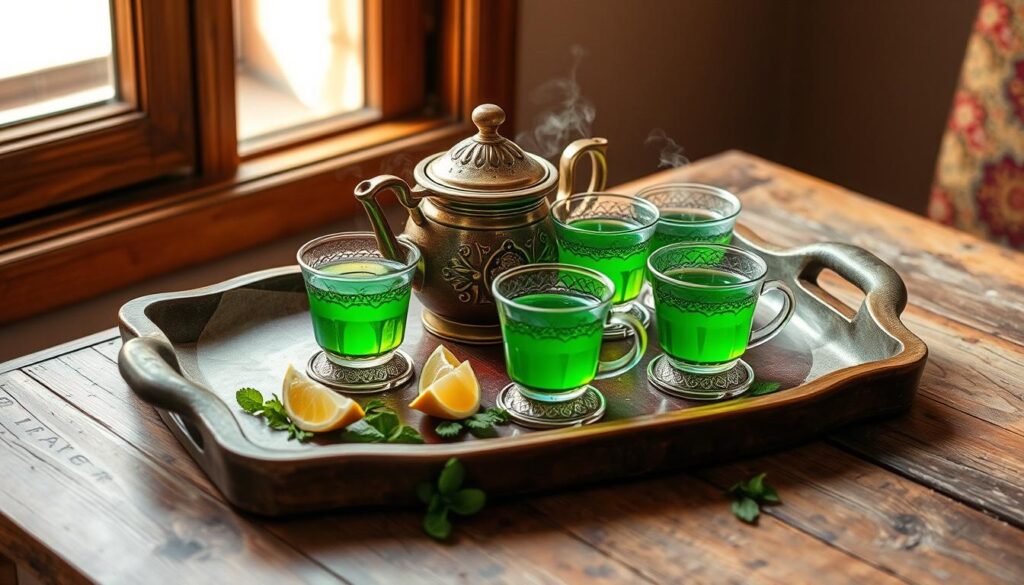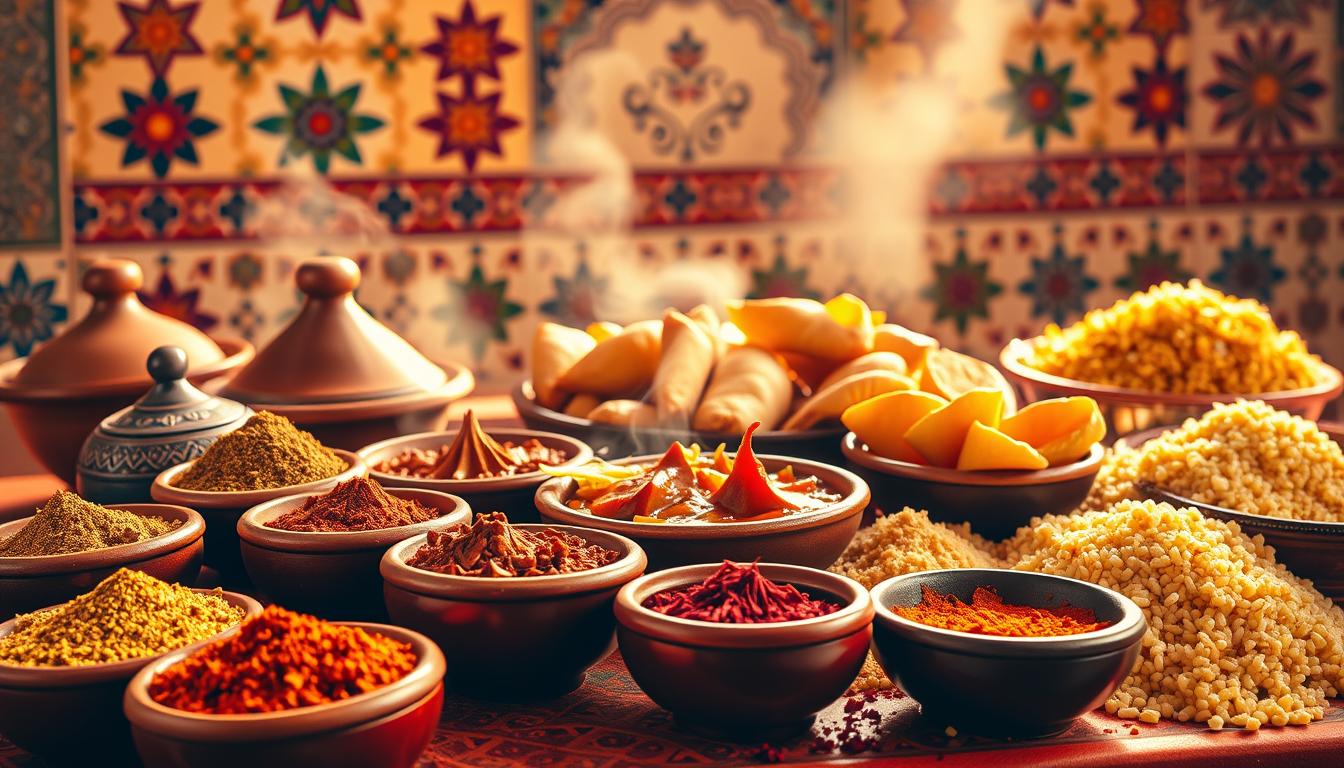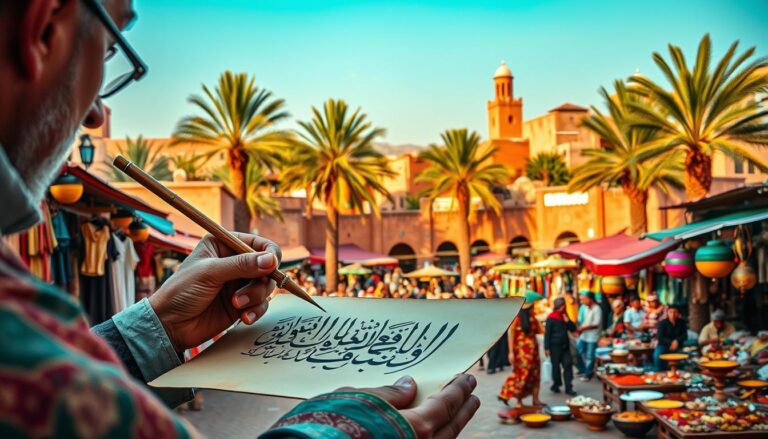Moroccan Food In Morocco
Table of Contents
Imagine walking through vibrant markets filled with the aroma of exotic spices and the sound of sizzling meats. Moroccan cuisine is a rich tapestry of flavors. It’s influenced by the country’s strategic position at the crossroads of Africa, Europe, and the Middle East.
You are about to embark on a culinary journey through the heart of Moroccan food culture. From the tangy preserved lemons to the hearty tagines, every dish tells a story of tradition and hospitality.
Key Takeaways
- Explore the essential dishes that define Moroccan cuisine.
- Understand the cultural significance of food in Moroccan society.
- Discover the must-try spices and cooking techniques.
- Learn how to recreate authentic Moroccan dishes at home.
- Get insights into planning a culinary trip to Morocco.
The Rich Heritage of Moroccan Food
Exploring Moroccan cuisine reveals a complex heritage shaped by many cultures. Moroccan food culture is diverse, showing the country’s history, geography, and cultural interactions.
Historical Influences on Moroccan Cuisine
Moroccan cuisine has been influenced by Arabs, Mediterraneans, and Africans. Spices like cumin, coriander, and cinnamon show the country’s ancient trade role. Tomatoes and peppers from the New World also added to Moroccan cooking.
Traditional Moroccan recipes mix these elements in unique ways. This creates dishes that are both familiar and exotic.
Regional Variations Across Morocco
Regional differences greatly influence Moroccan cuisine. Coastal areas are known for fresh seafood. Mountains and deserts have their own flavors and specialties.
The Rif Mountains are famous for fresh herbs and aromatic plants. Desert regions use preserved meats and dried fruits. This variety is seen in the different popular Moroccan spices used across regions.
| Region | Specialties | Key Ingredients |
|---|---|---|
| Coastal | Fresh seafood, grilled fish | Fish, olive oil, garlic |
| Mountainous | Tagines, preserved meats | Meat, dried fruits, nuts |
| Desert | Dried fruits, couscous | Dried fruits, grains, spices |
The regional differences in Morocco make its cuisine a rich and fascinating journey to explore.
Essential Moroccan Food You Must Try
To truly experience Moroccan cuisine, you need to try its most iconic and beloved dishes. Moroccan food reflects the country’s rich cultural heritage and history of trade and cultural exchange.
Iconic Tagine Dishes
Tagine dishes are a cornerstone of Moroccan cuisine, named after the earthenware pot in which they are cooked. These slow-cooked stews are made with a variety of ingredients, including meat, vegetables, and dried fruits.
Meat Tagines
Meat tagines are hearty and flavorful, often made with lamb or chicken cooked in a rich sauce with spices, herbs, and sometimes dried fruits. A classic example is the lamb tagine with prunes, which combines tender lamb with sweet and tangy prunes.
Vegetable Tagines
Vegetable tagines are just as delicious, featuring a mix of seasonal vegetables cooked in a flavorful broth. These dishes are often vegetarian-friendly and showcase the versatility of Moroccan cooking.
Couscous: The National Dish
Couscous is more than just a dish in Morocco; it’s a national symbol. Made from semolina flour, couscous is traditionally served on Fridays and on special occasions. It’s often accompanied by vegetables, meat, and sauce.
Street Food Favorites
Moroccan street food is a highlight of the culinary scene, offering a range of quick and delicious options. From sandwiches to snacks and small bites, there’s something for every taste.
Moroccan Sandwiches
Moroccan sandwiches are a staple of street food, often filled with grilled meats, vegetables, and a variety of sauces. Try a traditional Moroccan ‘bocadillo’, which is a satisfying and filling snack.
Snacks and Small Bites
Snacks and small bites are plentiful in Morocco, with popular options including fried doughnuts (known as ‘sfenj’), savory pastries, and spicy olives. These snacks are perfect for grabbing on the go.
As you explore Moroccan cuisine, you’ll find that these dishes are not just about sustenance; they’re about culture, tradition, and hospitality. As the famous Moroccan proverb goes,
“Food is the most intimate and personal expression of love.”
Understanding Moroccan Spices and Flavors
Exploring Moroccan cuisine reveals the importance of spices and flavors. Popular Moroccan spices add more than just taste. They showcase the country’s rich culture.
Moroccan cooking is known for its bold, aromatic tastes. These come from spice blends and special cooking methods. Ras el Hanout is a famous spice mix.
The Magic of Ras el Hanout
Ras el Hanout means “head of the shop.” It’s a mix of the best spices. It’s a key part of authentic Moroccan cuisine. This blend has over 30 spices, like cinnamon and cumin.
Common Herbs and Aromatics
Moroccan cooking also uses fresh herbs and aromatics. Parsley, cilantro, and garlic are common. They add freshness and depth to dishes. These ingredients work well with Moroccan cooking techniques like slow cooking.
Sweet and Savory Combinations
Moroccan cuisine is known for mixing sweet and savory flavors. Dishes often have fruits, nuts, and spices together. This mix shows the creativity of Moroccan cooking.
By learning about these elements, you can make Moroccan dishes at home. Try authentic Moroccan cuisine recipes and techniques.
How to Navigate a Moroccan Menu
Moroccan menus can seem daunting, but learning a few key terms can make your dining experience better. Knowing about the local cuisine and customs lets you enjoy the rich flavors and traditions of Moroccan food culture.
Common Menu Terms to Know
Learning common menu terms will help you order with ease. Some important words to know are:
- Tagine: a slow-cooked stew named after the earthenware pot in which it’s cooked
- Couscous: a traditional North African dish made from semolina flour
- Harira: a hearty soup made with tomatoes, lentils, and chickpeas
Knowing these terms will help you understand the dishes better and make better choices.
Ordering Etiquette in Moroccan Restaurants
When ordering in a Moroccan restaurant, it’s important to know the local customs and etiquette. Here are some tips:
Dining Customs
In Morocco, dining is a social and communal experience. Meals are often served family-style, and it’s customary to eat with your right hand.
Tipping Practices
Tipping in Morocco is expected, especially in restaurants and cafes. A tip of around 10% is standard, but you can adjust based on the service quality.

Where to Find the Best Moroccan Food
To truly taste Morocco, look beyond the tourist spots. The best Moroccan dishes are found in traditional restaurants, food markets, and home-cooked meals. These offer a deep dive into Moroccan food culture.
Traditional Restaurants vs. Tourist Spots
Finding top Moroccan restaurants means knowing the difference between local spots and tourist areas. Local restaurants serve authentic flavors and offer a real experience. Tourist places might focus on looks over taste.
- Choose restaurants that locals love.
- Check for traditional dishes like tagine and couscous.
- Steer clear of places with fancy menus or too many tourists.
Food Markets and Souks
Moroccan food markets and souks are lively places to try local foods. You’ll find fresh produce and street food, giving you a wide taste of Moroccan flavors.
- Go to souks early for the best produce.
- Try street foods like grilled meats and pastries.
- Visit different stalls for unique tastes.
Home-Cooking Experiences and Food Tours
For a deeper look into Moroccan food culture, try home-cooking classes or food tours. These let you learn cooking methods and enjoy tasty meals.
- Home-cooking classes teach you to make authentic dishes.
- Food tours take you on a culinary journey across regions.
Exploring traditional restaurants, food markets, and cooking experiences will enrich your understanding of Moroccan cuisine.
Moroccan Breakfast and Tea Culture
In Morocco, the day starts with a big breakfast and a hot cup of tea. This sets the stage for a lively cultural experience. Breakfast and tea are more than meals; they’re rituals that unite people.
Traditional Breakfast Dishes
Moroccan breakfasts are full of flavor and big portions. You’ll find dishes like shakshuka, a spicy egg dish, and msemen, a layered pancake. These dishes show the mix of culinary influences in Moroccan cuisine.
- Shakshuka: A flavorful egg dish with tomatoes and spices
- Msemen: Layered pancakes that can be sweet or savory
- B’stilla: A savory pie made with layers of flaky pastry, meat, and spices
The Art of Moroccan Mint Tea
Moroccan mint tea is a big part of the country’s culture and welcome. The way it’s made and served is full of tradition. It’s a special experience for both locals and visitors.
Tea Preparation Steps
- Select high-quality green tea leaves and fresh mint
- Rinse the tea leaves with boiling water to remove bitterness
- Add sugar and fresh mint to the tea pot
- Pour the tea from a height to create a frothy texture
Tea Serving Etiquette
Serving tea is a sign of respect and welcome in Morocco. When serving, pour the tea from high up to make a frothy top. The host serves the guests first. It’s polite to accept at least one cup as a thank you for the hospitality.

How to Cook Authentic Moroccan Food at Home
Start cooking authentic Moroccan cuisine at home with a few key ingredients and basic cookware. Moroccan cooking is famous for its rich flavors and aromas. This is thanks to traditional spices and cooking techniques.
Essential Cookware and Ingredients
You’ll need a tagine pot or a large clay pot with a conical lid to start. Don’t forget essential spices like cumin, coriander, cinnamon, and ginger. Also, have olive oil, lemons, and olives ready.
With these basics, you can make a variety of traditional Moroccan dishes. This includes hearty tagines and flavorful salads.
Simple Moroccan Recipes for Beginners
Beginners should start with simple recipes. Two great dishes to try are a basic tagine and a traditional Moroccan salad.
Basic Tagine Recipe
A tagine is a slow-cooked stew made in an earthenware pot. Brown your protein (chicken, beef, or lamb) in a pan. Then add onions, garlic, and spices. Put everything in the tagine pot, add liquid, and simmer until the meat is tender.
Moroccan Salad Recipe
The “salade marocaine” is a traditional Moroccan salad. It’s made with diced tomatoes, cucumbers, bell peppers, and onions. Dress it with olive oil, lemon juice, and paprika. This salad is perfect as a side dish for tagines and other Moroccan meals.
Tips from Moroccan Chefs
Moroccan chefs say using fresh, high-quality ingredients is key. They also stress the importance of balancing flavors. Patience is crucial, as many dishes are slow-cooked to develop deep flavors.
Follow these tips and practice with simple recipes. You’ll soon be cooking authentic Moroccan food at home.
Dietary Considerations: Vegetarian, Vegan, and Halal Options
Moroccan cuisine offers many options for different diets, like vegetarian, vegan, and halal. Its rich history and cultural influences make it diverse. This means there are many dishes for various dietary needs.
Moroccan food is great for vegetarians and vegans because it focuses on vegetables, fruits, and legumes. Many traditional dishes don’t have animal products or can be made vegan.
Plant-Based Moroccan Specialties
Morocco has many tasty plant-based dishes for vegetarians and vegans. Some favorites include:
- Vegetable tagines, rich in flavor and aroma
- Couscous with vegetables and herbs
- Stuffed bell peppers with a mix of rice, herbs, and spices
- Harsha, a spicy chili pepper paste served with bread
These dishes show the variety and richness of Moroccan cuisine for plant-based diets.
Navigating Food Restrictions in Morocco
Understanding food restrictions in Morocco is key. Vegetarians and vegans should learn basic Arabic or French phrases. This helps communicate dietary needs. Many Moroccans are welcoming, especially in tourist spots.
| Dietary Preference | Key Phrases | Common Foods |
|---|---|---|
| Vegetarian | “Ana nabati” (I am vegetarian) | Vegetable tagines, couscous |
| Vegan | “La akol laham” (I don’t eat meat), “La akol dairy” (I don’t eat dairy) | Stuffed bell peppers, harsha |
| Halal | “Halal” (permissible food) | Meat dishes certified halal |
Knowing these dietary tips helps you enjoy Morocco’s food fully.
Conclusion: Embracing the Flavors of Morocco
Exploring Moroccan food opens a world of rich flavors and history. The use of aromatic spices and hearty tagine dishes is a feast for the senses. It leaves you craving more.
Whether you love food, travel, or cooking, Moroccan cuisine has something special. You can try making Moroccan dishes at home or visit Morocco to taste it all. The vibrant food markets and souks are a must-see.
Moroccan food is more than just flavors and ingredients. It’s about the people, culture, and traditions that make it unique. Start your Moroccan culinary journey today. Discover the warmth and hospitality of sharing a delicious meal.






2 Comments